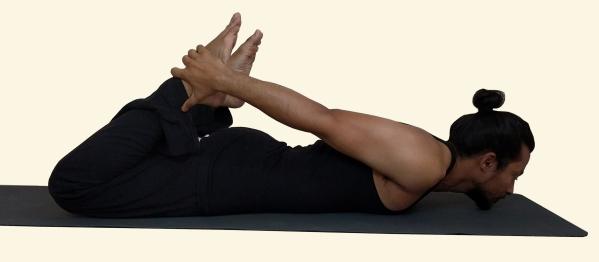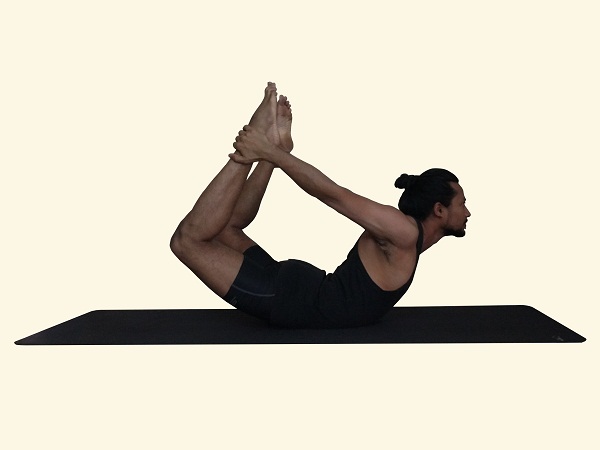Dhanur means bow. Dhanurasana is one of the postures which is mentioned in an old Yogic text Hatha Yoga Pradipika. Given below is the verse from the same text describing Dhanurasana
पादाङ्गुष्ह्ठौ तु पाणिभ्यां गॄहीत्वा शरवणावधि |
धनुराकर्ष्हणं कुर्याद्धनुर-आसनमुछ्यते || २७ ||
pādāngghuṣhṭhau tu pāṇibhyāṃ ghṝhītvā śravaṇāvadhi |
dhanurākarṣhaṇaṃ kuryāddhanur-āsanamuchyate || 27 ||
Meaning: Holding both the toes of the feet from both the hands, bringing them up to the ear imitating a stretched bow, is called Dhanurasana.
The bow pose is a great exercise to bring the spine and the pelvis back to the neutral position after spending all your time on a desk job. It stretches the hip flexors, strengthens the back muscles, and opens your chest relieving the stress and tension from the body.
Steps:
- Lie down on your stomach.
- Bend both your knee and hold your respective ankles.
- Depending on the flexibility of your flexors you may find that the pelvis might lift up leaving a gap between the floor and your hips. Engage the core and the glutes to tilt the pelvis and press the thigh into the floor.

- Inhale and lift your thigh and chest up trying to balance on your stomach (lift your upper body up by pulling your hands with your legs, the more you pull with your legs the more your chest will lift up).
- Stay in this position for about 30 seconds and then exhale placing your knee-chest and chin slowly on the ground.

Important!
Anterior pelvic tilt and Dhanurasana
If you have anterior pelvic tilt (APT) then you might find that the bow pose compresses your lower back and it might even be painful for the lower back. The reason might be tight hip flexors that don’t allow the pelvis to tilt posteriorly. We recommend you work on the hip flexors first (the first photo on this page).
Pelvic bone digging into the floor
If you are thin then the pelvic bone might be digging into the ground, in that case, put a soft thin cushion under the pelvis.
Benefits:
- Stretches and strengthens the thighs (quadriceps).
- Stretches and tones the abdominal muscles, back muscles, chest muscles (intercostal muscles), and arms.
- Can be used as a therapeutic posture for diabetes and asthma.
- Relieves from menstrual discomfort and constipation.
- Strengthens the diaphragm.
Contraindications:
- A disease of the backbone, abdominal surgery, hernia, or stomach ulcers.
Looking for other postures? Explore our Yoga postures library.